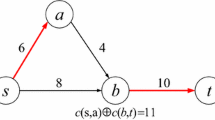Abstract
In this paper, we investigate the routing optimization problem in wireless mesh networks. While existing works usually assume static and known traffic demand, we emphasize that the actual traffic is time-varying and difficult to measure. In light of this, we alternatively pursue a stochastic optimization framework where the expected network utility is maximized. For multi-path routing scenario, we propose a stochastic programming approach which requires no priori knowledge on the probabilistic distribution of the traffic. For the single-path routing counterpart, we develop a learning-based algorithm which provably converges to the global optimum solution asymptotically.





Similar content being viewed by others
Notes
In this paper, we slightly abuse the notation by using the same symbol for a set and its cardinality for notation brevity.
Note that the actual network topology can be much larger.
References
Akyildiz IF, Wang X (2005) A survey on wireless mesh networks. IEEE Commun Mag 43(9):S23–S30
Zhang Y, Roughan M, Lund C, Donoho D (2003) An information-theoretic approach to traffic matrix estimation. ACM Sigcomm, pp 301–302
Soule A, Lakhina A, Taft N, Papagiannaki K, Salamatian K, Nucci A, Crovella M, Diot C (2005) Traffic matrices: balancing measurements, inference and modeling. ACM Sigmetrics pp 362–373
Medina A, Taft N, Salamatian K, Bhattacharyya S, Diot C (2002) Traffic matrix estimation: existing techniques and new directions. ACM Sigcomm, pp 161–174
Applegate D, Cohen E (2003) Making intra-domain routing robust to changing and uncertain traffic demands: understanding fundamental tradeoffs. ACM Sigcomm, pp 313–324
Wang H, Xie H, Qiu L, Yang YR, Zhang Y, Greenberg A (2006) Cope: traffic engineering in dynamic networks. ACM Sigcomm, pp 99–110
Li Y, Bai B, Harms J, Holte R (2007) Multipath oblivious routing for Traffic Engineering - stable and robust routing in changing and uncertain environments. International teletraffic congress (ITC 2007), 17–21 June 2007, pp 129–140
Li Y, Harms J, Holte R (2006) Traffic-oblivious energy-aware routing for multihop wireless networks. Proc IEEE Infocom, pp 1–12
Wang W, Liu X, Krishnaswamy D (2007) Robust routing and scheduing in wireless mesh networks. IEEE SECON, pp 471–480
Dai L, Xue Y, Chang B, Cao Y, Cui Y (2008) Integrating traffic estimation and routing optimization for multiradio multi-channel wireless mesh networks. Proc IEEE Infocom, pp 71–75
Zhang J, Zheng D, Chiang M (2008) The impact of stochastic noisy feedback on distributed network utility maximization. IEEE Trans Inf Theory 54(2):645–665
Lee JW, Mazumdar RR, Shroff NB (2007) Joint opportunistic power scheduling and end-to-end rate control for wireless ad-hoc networks. IEEE Trans Veh Technol 56:801–809, March
Lee JW, Mazumdar RR, Shroff NB (2006) Opportunistic power scheduling for dynamic multi-server wireless systems. IEEE Trans Wirel Commun 5:1506–1515, June
Lee JW, Mazumdar RR, Shroff NB (2004) Opportunistic power scheduling for multi-server wireless systems with minimum performance constraints. Proc IEEE Infocom 2:1067–1077
Kleinrock L (1975) Queueing systems, vol 1, 1st edn—theory. Wiley, New York
Chiang M (2004) To layer or not to layer: balancing transport and physical layers in wireless multihop networks. Proc IEEE Infocom, pp 2525–2536
Chiang M, Low SH, Calderbank AR, Doyle JC (2007) Layering as optimization decomposition: a mathematical theory of network architectures. Proc IEEE 95:255–312, March
Kelly F, Maulloo A, Tan D (1998) Rate control in communication networks: shadow prices, proportional fairness and stability. J Oper Res Soc 49:237–252
Bertsekas DP (1999) Nonlinear programming. Athena Scientific, Nashua
Kall P, Wallace SW (1994) Stochastic programming. Wiley, New York
van der Vlerk MH Stochastic integer programming bibliography (1996–2007). http://mally.eco.rug.nl/biblio/sip.html
Xing Y, Chandramouli R (2007) Price dynamics in competitive agile spectrum access markets. IEEE J Sel Areas Commun (JSAC) 25:613–621, March
Haleem MA, Chandramouli R (2005) Adaptive downlink scheduling and rate selection: a cross layer design. IEEE J Sel Areas Commun 23:1287–1297, June
Haleem MA, Chandramouli R (2004) Adaptive transmission rate assignment for fading wireless channels with pursuit learning algorithm. In: Proceedings of CISS, Princeton
Kiran S, Chandramouli R (2003) An adaptive energy-efficient link layer protocol using stochastic learning control. IEEE Int Conf Commun (ICC) 2:1114–1118
Xing Y, Chandramouli R (2004) Distributed discrete power control for bursty transmissions over wireless data networks. IEEE Int Conf Commun (ICC) 1:139–143
Song Y, Fang Y, Zhang Y (2007) Stochastic channel selection in cognitive radio networks. IEEE Globecom, pp 4878–4882
Thathachar MAL, Sastry PS (2002) Varieties of learning automata: an overview. IEEE Trans Syst Man Cybern 32:711–722, December
Zeng G, Wang B, Ding Y, Xiao L, Mutka M (2007) Multicast algorithms for multi-channel wireless mesh networks. IEEE ICNP, pp 1–10
Thathachar MAL, Sastry PS (2004) Networks of learning automata. Kluwer Academic, Dordrecht
Kushner HJ (1984) Approximation and weak convergence methods for random processes. MIT, New York
Aluffi-Pentini F, Parisi V, Zirilli F (1985) Global optimization and stochastic difference equations. J Optim Theory Appl 47:1–26
Acknowledgements
This work was supported in part by the U.S. National Science Foundation under Grant DBI-0529012 and under Grant CNS-0721744. The work of Fang was also partially supported by Changjiang Scholar Chair Professorship and the 111 Project under B08038.
Author information
Authors and Affiliations
Corresponding author
Rights and permissions
About this article
Cite this article
Song, Y., Zhang, C. & Fang, Y. Harnessing Traffic Uncertainties in Wireless Mesh Networks—A Stochastic Optimization Approach. Mobile Netw Appl 14, 124–133 (2009). https://doi.org/10.1007/s11036-008-0137-2
Published:
Issue Date:
DOI: https://doi.org/10.1007/s11036-008-0137-2




